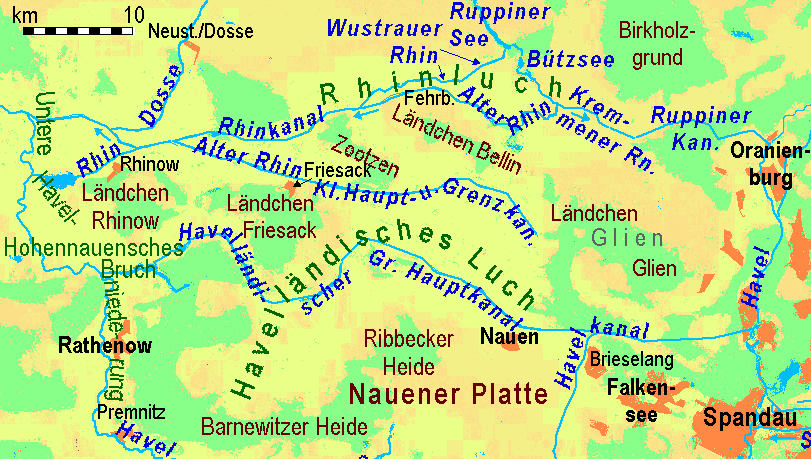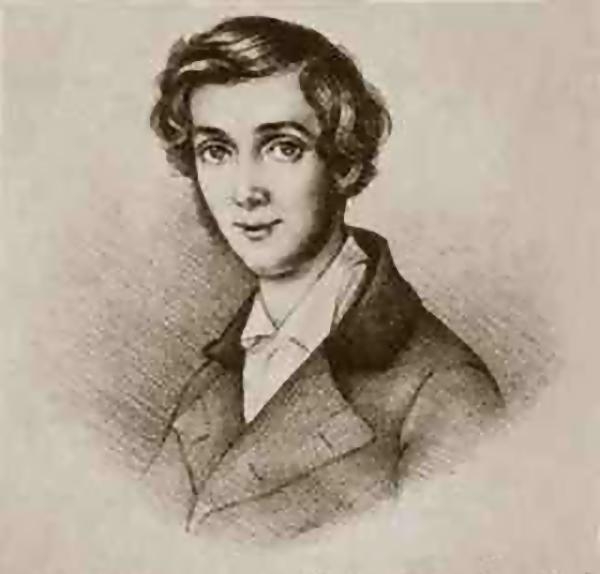|
Rhinluch
The Rhinluch is a fen landscape in the German state of Brandenburg, bisected by the river Rhin to which it owes its name. This wetland region lies north of Fehrbellin in the county of Ostprignitz-Ruppin. The upper Rhinluch covers an area of about . The suffix ''luch (landform), luch'' is used to describe several wet areas in the state of Brandenburg, in which, prior to the advent of modern Drainage system (geomorphology), drainage systems, water remained largely stagnant rather than flowing. The Rhinluch was formed during the last Weichselian glaciation, ice age and its Holocene, post-glacial period. About 16,000 years ago, the Eberswald ''urstromtal'' was formed by the meltwaters of the glacial ice sheet as they drained away to the sea. Later, this broad river valley dried up as the ice sheet retreated during the late ice age. In the land that makes up the present-day Rhinluch, lakes initially formed in individual places, especially where there were dead ice kettle holes. Over t ... [...More Info...] [...Related Items...] OR: [Wikipedia] [Google] [Baidu] |
Luch (landform)
The term ''Luch'' (plural: ''Luche'') is German and refers to an area of originally expansive, marshy or boggy lowland in northeast Germany, especially in the state of Brandenburg. ''Luche'' are found mainly in Young Drift regions; but they also occur on Old Drift landscapes. According to Leser the term should not be translated. Location and history ''Luche'' mainly formed in the main urstromtal valleys or their side valleys. After the end of the Last Glacial Period, Ice Age, the water table rose during the Holocene, postglacial period resulting in the formation of bogs. The peat thickness is not particularly great; in most cases it is less than 2 metres thick. Before the installation of artificial drainage networks excess water often accumulated in the ''Luche'' in ponds. In contrast with lowlands with natural watercourses, they were give a different name from the neighbouring ''Bruche'' (Carr (landform), carrs), such as the Oderbruch to the east and the Hohennauen Bruch on t ... [...More Info...] [...Related Items...] OR: [Wikipedia] [Google] [Baidu] |
Ländchen Friesack
''Ländchen Friesack'' is a small ridge, up to 77 metres above sea level (NN). It is situated in Brandenburg, northwest of Germany's capital city, Berlin and southwest of the town of Friesack. The '' Ländchen'' (German for "small land" or "little territory") extends for just under 5 kilometres in a north-south direction and separates the lowland and former marshes of the Rhinluch in the north from that of the Havelland Luch in the south. The upland is almost entirely forested. It is divided into the parishes of Friesack, Kleßen-Görne and Mühlenberge. Part of the ''Ländchen'' – around the lake of Görner See – is a nature reserve A nature reserve (also known as a wildlife refuge, wildlife sanctuary, biosphere reserve or bioreserve, natural or nature preserve, or nature conservation area) is a protected area of importance for flora, fauna, funga, or features of geologic .... References Literature * {{DEFAULTSORT:Landchen Friesack Havelland Landforms of Br ... [...More Info...] [...Related Items...] OR: [Wikipedia] [Google] [Baidu] |
Silting
Siltation is water pollution caused by particulate Terrestrial ecoregion, terrestrial Clastic rock, clastic material, with a particle size dominated by silt or clay. It refers both to the increased concentration of suspended sediments and to the increased accumulation (temporary or permanent) of fine sediments on bottoms where they are undesirable. Siltation is most often caused by soil erosion or sediment spill. It is sometimes referred to by the ambiguous term "sediment pollution", which can also refer to a chemical contamination of sediments accumulated on the bottom, or to pollutants bound to sediment particles. Although "siltation" is not perfectly stringent, since it also includes particle sizes other than silt, it is preferred for its lack of ambiguity. Causes The origin of the increased sediment transport into an area may be erosion on land or activities in the water. In rural areas, the erosion source is typically soil degradation by intensive or inadequate agricultu ... [...More Info...] [...Related Items...] OR: [Wikipedia] [Google] [Baidu] |
Friesack
Friesack (; also Friesack/Mark) is a town in the Havelland district, in Brandenburg, in north-eastern Germany. It is situated northeast of Rathenow, and southwest of Neuruppin. It is known for its Mesolithic archaeological site. History During World War II, in September 1943, the Oflag 8 German prisoner-of-war camps in World War II, prisoner-of-war camp was relocated from Lübben (Spreewald), Frauenberg to Wutzetz, present-day district of Friesack. Polish, Greek, Bulgarian and Romanian officers were held in the camp before its dissolution in April 1945. Film shot in Friesack * 1923 : Die Schlucht des Todes (The Ravine of Death) directed by Luciano Albertini and Albert-Francis Bertoni Demography Sons and daughters of the town * Emil Schallopp (1843-1919), chess master and writer * Karsten Wettberg (born 1941), football coach * Adalbert von Bredow (1814-1890), Prussian general References Localities in Havelland {{Brandenburg-geo-stub ... [...More Info...] [...Related Items...] OR: [Wikipedia] [Google] [Baidu] |
Ländchen Bellin
The Ländchen was a region east of Wiesbaden, Germany that comprised ten villages: Breckenheim, Delkenheim, Diedenbergen, Igstadt, Langenhain, Massenheim, Medenbach, Nordenstadt, Wallau, and Wildsachsen, plus Domäne Mechtildshausen. Ländchen was a Hessian territory for about 300 years. It was bounded by the County of Nassau to the west and the territory of the Archbishopric of Mainz to the east. (It is distinct from the Blue Ländchen at Nastätten.) Breckenheim, Delkenheim, Igstadt, Medenbach, and Nordenstadt are now boroughs of Wiesbaden. Domäne Mechtildshausen is also part of the borough of Wiesbaden-Erbenheim. Diedenbergen, Langenhain, Wallau, and Wildsachsen are now boroughs of Hofheim am Taunus. Massenheim is a borough of Hochheim am Main. The Ländchen gives its name to a railway line, the Ländchesbahn, which traverses this territory. History The Ländchen was sold by Count Gottfried IX (X) of Eppstein-Münzenberg in 1492 to the Landgrave William III "The Y ... [...More Info...] [...Related Items...] OR: [Wikipedia] [Google] [Baidu] |
Wanderungen Durch Die Mark Brandenburg
''Wanderungen durch die Mark Brandenburg'' ("Ramblings through Brandenburg", "Rambles in Brandenburg" or "Walks through the Margraviate of Brandenburg, March of Brandenburg") is a five-volume travelogue by the Germany, German writer Theodor Fontane, originally published in 1862–1889. It is his longest work and forms a bridge between his early career as a poet and his later novels. It covers the history, architecture, and people of the region as well as its landscape, and influenced the German Youth Movement of the early twentieth century. Background and composition In his preface, Fontane wrote that the inspiration for ''Wanderungen durch die Mark Brandenburg'' came on a visit to Loch Leven Castle in Scotland in 1858, when he remembered visiting Rheinsberg Palace, a similarly situated castle in Brandenburg, and realised the two were comparably memorable experiences; so he decided to share with the German readership the attractions of his native region. He began the trips thr ... [...More Info...] [...Related Items...] OR: [Wikipedia] [Google] [Baidu] |
Theodor Fontane
Theodor Fontane (; 30 December 1819 – 20 September 1898) was a German novelist and poet, regarded by many as the most important 19th-century German-language Literary realism, realist author. He published the first of his novels, for which he is best known today, only at age 58 after a career as a journalist. Many of his novels delve into topics that were more or less taboo for discussion in the polite society of Fontane's day, including marital infidelity, class differences, urban vs. rural differences, abandonment of children, and suicide. His novels sold well during his lifetime and several have been adapted for film or audio works. Fontane's novels are known for their complex, often sceptical view of society in the German empire. He shows different social and political parts of society meeting and sometimes clashing, his main characters range from lower-middle class to Prussian nobility. Fontane is known as a writer of realism, not only because he was conscientious about th ... [...More Info...] [...Related Items...] OR: [Wikipedia] [Google] [Baidu] |
European Pond Turtle
The European pond turtle (''Emys orbicularis''), also called Common name, commonly the European pond terrapin and the European pond tortoise, is a species of long-living freshwater turtle in the Family (biology), family Emydidae. The species is Endemism, endemic to the Western Palaearctic, Western Palearctic. Subspecies The following 14 subspecies are recognized as being valid. *''Emys orbicularis capolongoi'' – Sardinian pond turtle *''Emys orbicularis colchica'' – Colchis pond turtle *''Emys orbicularis eiselti'' – Eiselt's pond turtle *''Emys orbicularis fritzjuergenobstii'' – Obst's pond turtle *''Emys orbicularis galloitalica'' – Italian pond turtle *''Emys orbicularis hellenica'' – Western Turkey pond turtle *''Emys orbicularis hispanica'' – Spanish pond turtle *''Emys orbicularis iberica'' – Kura Valley pond turtle *''Emys orbicularis ingauna'' - Ligurian pond turle *''Emys orbicularis lanzai'' – Corsican pond turtle *''Emys orbicularis luteofusc ... [...More Info...] [...Related Items...] OR: [Wikipedia] [Google] [Baidu] |
Kremmener Luch
The Kremmener Luch is a shallow fen, known locally as a '' luch'', between the Glien plateau (near Berlin) in the south, and the Beetzer Heath in the north. Overview The western Rhin flows through the Kremmener Luch, where it is called the Kremmener Rhin, or the Ruppiner Canal. The Kremmen Lake, which is embedded in the Kremmener Luch, was converted into a nature preserve in 1924. This wildlife preserve is 11 square kilometres large today, and there can one can still see cranes, beavers, and European otters. For 300 years the Kremmener Luch has been drying up, and today, the greater part of it is suitable for agricultural usage, and has thus lost its moorish character. The Kremmer Dam, scene of the decisive battle which established the Hohenzollern The House of Hohenzollern (, ; , ; ) is a formerly royal (and from 1871 to 1918, imperial) German dynasty whose members were variously princes, electors, kings and emperors of Hohenzollern, Brandenburg, Prussia, the German Em ... [...More Info...] [...Related Items...] OR: [Wikipedia] [Google] [Baidu] |
Land Improvement
Land development is the alteration of landscape in any number of ways, such as: * Changing landforms from a natural or semi-natural state for a purpose such as agriculture or housing * Subdividing real estate into lots, typically for the purpose of building homes * Real estate development or changing its purpose, for example by converting an unused factory complex into a condominium History Land development has a history dating to Neolithic times around 8,000 BC. From the dawn of civilization, the process of land development has elaborated the progress of improvements on a piece of land based on codes and regulations, particularly housing complexes. Economic aspects In an economic context, land development is also sometimes advertised as land improvement or land amelioration. It refers to investment making land more usable by humans. For accounting purposes, it refers to any variety of projects that increase the value of the process. Most are depreciable, but some land improv ... [...More Info...] [...Related Items...] OR: [Wikipedia] [Google] [Baidu] |
Swamp
A swamp is a forested wetland.Keddy, P.A. 2010. Wetland Ecology: Principles and Conservation (2nd edition). Cambridge University Press, Cambridge, UK. 497 p. Swamps are considered to be transition zones because both land and water play a role in creating this environment. Swamps vary in size and are located all around the world. The water of a swamp may be fresh water, brackish water, or seawater. Freshwater swamps form along large rivers or lakes where they are critically dependent upon rainwater and seasonal flooding to maintain natural water level fluctuations.Hughes, F.M.R. (ed.). 2003. The Flooded Forest: Guidance for policy makers and river managers in Europe on the restoration of floodplain forests. FLOBAR2, Department of Geography, University of Cambridge, Cambridge, UK. 96 p. Saltwater swamps are found along tropical and subtropical coastlines. Some swamps have hammock (ecology), hammocks, or dry-land protrusions, covered by aquatic vegetation, or vegetation that tolerate ... [...More Info...] [...Related Items...] OR: [Wikipedia] [Google] [Baidu] |








